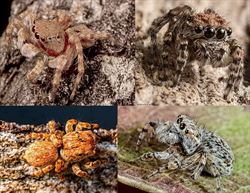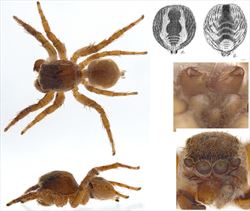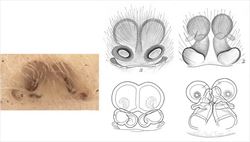
Examples of live Grayenulla
Illustrator (and ©) R. Whyte

Aspects of the general morphology of Grayenulla
Illustrators (and ©) B.J. Richardson (CSIRO), M. Zabka (diag.) (AMS)

Palp morphology of Grayenulla sp. (L), G. spinimania (M) and G. wilganea (R)
Illustrators (and ©) B.J. Richardson (CSIRO) & M. Zabka (diag.) (AMS)

Epigyne morphology of Grayenulla sp., (L), G. spinimania (M) and G. wilganea (R)
Illustrators (and ©) B.J. Richardson (CSIRO), M. Zabka (diag.) (AMS)
Grayenulla Zabka, 1992
Taxonomy
Grayenulla has seven Australian species; Grayenulla australensis, G. dejongi, G. nova, G. spinimana, G. waldockae, G. wilganea and G. wishartorum. Other undescribed species have been reported (Whyte unpubl.) Further information on the genus and described species can be found in Richardson and Żabka (2017) and Whyte and Anderson (2017).
Description
Grayenulla spp. are small to medium-sized spiders, length 3 to 5 mm, with an oval abdomen shorter than the cephalothorax. The head, viewed from above, is pear-shaped, widest behind the posterior lateral eyes. The carapace is high, rounded, with a steep thoracic slope. The clypeus has three protruding strong median bristles. Chelicerae have a divided (fissident) retromarginal tooth and two or three promarginal teeth. The third pair of legs is longer than the others. None of the legs is massive in build.
The male’s palp is thickly hairy. The femur and patella have an apparently fused connection. The enlarged palpal femur has a distinctive triangular apophysis. The palpal patella and tibia have distinctive lateral brushes. There are retro-lateral and dorsal tibial apophyses. The tegulum is usually triangular in shape with a lateral process. The embolus may be either straight or coiled and varies considerably in shape between species.
The female has two epigynal atria and often two lateral pockets with sclerotised margins. The copulatory openings are located deep in each atrium. The spermathecae are convoluted, multi-chambered and within or between the margins of the atria.
Biology
Grayenulla has usually been collected in pitfall traps, though it has also been collected when sweeping foliage. It is found in a very wide range of northern environments ranging from rainforest to deserts, in litter, under rocks or out on the surface.
Distribution
The genus has been collected across the warmer half of Australia north of the Australian Capital Territory and Port Hedland.
References
Richardson, B.J. & Żabka, M. 2016. Salticidae. Arachnida: Araneomorphae. Canberra, Australian Faunal Directory. Australian Biological Resources Study, at https://biodiversity.org.au/afd/taxa/SALTICIDAE.
Żabka, M. 1992. Salticidae (Arachnida: Araneae) from Oriental, Australian and Pacific Regions, VII. Paraplatoides and Grayenulla — New genera from Australia and New Caledonia. Records of the Australian Museum 44, 165-183.
Żabka, M. & Gray, M.R. 2002. Salticidae (Arachnida: Araneae) from Oriental, Australian and Pacific Regions, XVI. New species of Grayenulla and Afraflacilla. Records of the Australian Museum 54, 269-274.
Whyte, R. & Anderson, G. 2017. A Field Guide to Spiders of Australia. CSIRO Publishing: Clayton.
* The information sheet should be interpreted in the context of the associated diagrams and photographs. Diagrams explaining anatomical terms can be found in the ‘Salticidae’ pictures at the beginning of the list of genera.